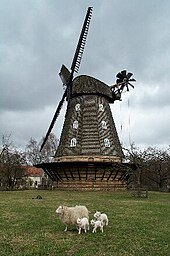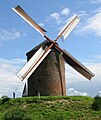Dutch windmill

The Dutch windmill , also known locally as a cap windmill (in the Netherlands generally called bovenkruier , top- slewing , i.e. with a rotatable hood or cap), is the most modern development of the classic windmill . In the 16th century, this type of windmill replaced the post mills built before, especially in the Netherlands and northern Germany . While Dutch windmills were mainly used as grain mills in the rest of Europe , in the Netherlands they were mainly used as wind pumps to drain the polders .
description
It owes its German name to Dutch mill builders, with the Dutch engineer and mill designer Jan Adriaanszoon Leeghwater being named as the inventor of the rotating cap. The lower part of these mills is usually bricked or constructed from beams (Alt Schwerin Mill), making it extremely stable and exerting less pressure on the ground because it has no individual foundations. The movable head (cap or hood) of the mill with the blades attached to the blade shaft, which rests on the "tower" made of wood or masonry, can be rotated on the rollers (formerly made of wood, later made of steel ) and Krühring (Lower German: Kroyring) stored at the top of the tower. A sanding cap does not require rollers and sits on sanding boards that are lubricated with soft soap. So only the upper part - the cap (boat, onion, cone-shaped) - had to be turned into the wind. Originally with an internal rake, a rotating mechanism built into the hood (15th century), which makes some of these mills (depending on the internal rake, which is also operated from the gallery via a gear with an endless chain protruding from the end of the cap) appear more compact because of the larger hood. Since the late 16th century, they have been increasingly equipped with external rake, consisting of five control bars (four V-shaped "swords" or "Schoren" with a central, actual codend (Sterz)), which protrudes from the side of the cap "Spreet bar" (Crossbar) the cap is operated by means of a jogger attached to the end of the codend, or with a compass rose (automatic wind tracking) attached to the end of the cap on a solid frame , patented in 1745 by the Englishman Edmund Lee from Brockmill Forge near Wigan . The lower, fixed part, on the other hand, could be used as the actual work platform ( grinder , sawmill , pumping station, etc.), for storage and loading of goods, and also as an apartment and sales room. High Dutch mills thus have several floors or floors (Söller, Low German Soller , ndl. Zolder ), here for a nine-story mill, starting with
- Cap floor (Radstube, nld. Kapzolder , engl . Dust floor / cap floor ) - protects against weather influences through the cap, including the
- Lifting floor or bulk floor (nld. Luizolder , English hoist floor / bin floor ) - here the grain is poured in some mills,
- Stone floor or grinding floor (nld. Steenzolder , engl. Stone floor ),
- Mehlboden (nld. Maalzolder / meelzolder , English meal floor ),
- Gallery floor (with apartment / (Ab) sackboden) (nld. Baliezolder & woonhuis / zakzolder , engl. Gallery (stage) floor & living floor / sack floor ),
- Warehouse floor (nld. Opslagzolder , engl. Grain floor ),
- Kornlager (nld. Graan opslagzolder , engl. Grain store ),
- Living floor (nld. Woonhuis , engl. Bedroom / living floor ),
- Entrance hall / basement / apartment (nld. Invaart / woonhuis , engl. Living room / cellar floor ).
The floors under the gallery often differ, depending on the type of mill and the number of floors, and form the substructure. In gallery mills with stone substructures, often only the number of floors below the gallery is counted, which does not correspond to the actual number of floors.
In addition to static advantages compared to the architecturally older post mills, this meant more space in the building to accommodate milling machines , the mill tower could be built higher into the wind, which increased the efficiency of the “windmill” machine accordingly. The force was in this type by means of a gear from cog wheel on the wing over the shaft Obenbunkler or -bunkel to the vertical rotating shaft, the so-called vertical shaft transmitted. This drive train cannot be disconnected during normal operation, so that when the sashes are rotating, the energy in the building can be taken from the rotating vertical shaft and transferred to all types of machines. Polder mills have the lower bunker or bunker at the lower end of the vertical shaft, which transfers the force to the Archimedean screw . Depending on the type, sawmills either drive two side-mounted crankshafts via the vertical shaft, which transfer the rotary motion to a vertical movement of the saw blades, or a large crankshaft without a vertical shaft directly via the comb wheel.
The Dutch windmill spread very widely in Northern Europe. Only the high construction costs impaired their spread.
Types of Dutch mills
Earth Dutchman
Dutch mill built at ground level, without a stone ground floor, the wing tips close to the ground. Also called Grundsegler ( ndl. Grondzeiler ). With sail gate wings , the operation can be done from the ground, from there the miller climbs into the wings.
Plinth floor Dutchman
Dutch mill built on the ground floor with a stone ground floor.
Wallholländer (Bergholländer)
Instead of a gallery (see Galerieholländer below ), the mill was built on an artificial earth wall. This brought the impeller higher up in the wind, the wings could be reached from the artificial mound, e.g. B. at the mill in Straupitz (Spreewald) . Bergmolen or also called grondzeiler in the Netherlands .
Transit Dutchman (cellar Dutchman)
Variation of the Wall Dutchman. You can drive into the mill base on one side with a cart or tractor and back out on the other side. In the middle of the passage, in the mill cellar, so to speak, the flour or grain sacks are then loaded and unloaded with the mill's own hoist.
Gallery Dutch
Due to the considerably larger construction heights of some Dutch windmills, it was no longer possible to reach the wings or the codend. Both had to be possible for the windmill to be operated properly. A kind of wrap-around balcony or gallery was therefore invented from which wings such as codend and brake could be operated. These types are called "Galerieholländer (mühlen)" (ndl. Stellingmolen ).
Tower Dutchman
Conically made of bricks and / or rubble stones, both round and polygonal (Cyclops); never called torenmolen (tower mill) in the Netherlands , these are squat windmills with a cylindrical or slightly conical mill tower (only four survived: three as internal turner in Lienden (De Zwaan, 1644), Zeddam (De Grafelijke Korenmolen, 1441) and Zevenaar ( De Buitenmolen, 1450) and one in Eijsden -Gronsveld (van Gronsveld, 1623) as external turner (ndl. Buitenkruier)), but z. B. as stenen grondzeiler (stone ground sailor ), stenen bergmolen (stone mountain mill) or stenen stellingmolen (stone gallery mill) .
Mixed forms
A tower dutchman can be designed as a basement dutchman (transit dutchman), gallery dutchman or as a wall dutchman. There are also gallery Dutch with a passage. A clear typing is therefore sometimes quite difficult and depends heavily on the preferred aspect of the viewer. A special form is the type of mill, often referred to as a "dutchman", of a dutch mill placed on top of an existing building. If the building is a water mill , it is a " wind water mill " (ndl. Watervluchtmolen).
Examples
- Carolinensieler Mühle, Galerieholländer (1742), 5-storey, 8-sided, new wings were installed on June 23, 1993.
- Gallery mill "Hager Mühle" (1888), 5-storey, 8-sided (30.2 m cap height) on 6-storey, octagonal brick substructure , Hage , Germany's highest windmill.
- Stone gallery mill " Amanda " (1888), 5-storey, 8-sided as a grain and saw mill (30 m cap height) on a 4-storey, square brick substructure , Kappeln .
- Stone gallery mill " Kalkarer Mühle " (1772), eight floors, round from bricks built in 1770 as a lohmühle (27.6 m cap height), Kalkar , highest windmill on the Lower Rhine, since 1999 after renovation grindable grain mill.
- Stone gallery mill “De Nolet” (2006), 10-storey, round made of bricks as an energy generator (43 m cap height), Schiedam , Netherlands ; tallest windmill in the world.
- Steinwallholländer "Straupitz" (1850) , 5-storey, round as a triple windmill (grain, oil and saw mill), Straupitz (Spreewald) ; only one in Europe.
- Stone tower windmill "Steprather Mühle" (approx. 1470) as a grain mill, Walbeck (Geldern) ; Germany's oldest working windmill ( 15th century ).
- Peldemühle in Wittmund Galerieholländer (1741), 4-story, 8-sided made of wood / one-story stone substructure as a grain and peldemühle ; oldest gallery Dutch mill in Germany
- Siuts mill in Wittmund. Two-story gallery Dutch from 1884.
- Gallery Dutch " Vareler Windmühle " (1848), 4-storey, 8-sided made of wood (28.8 m cap height), Varel , on 5-storey octagonal clinker base; second largest windmill in Germany with nine floors and the largest preserved millstone in Germany. Now used as the “Vareler Heimatmuseum”.
- Stone gallery mill " Heckington " ( Heckington tower mill , 1830/1892), 6-storey, built round from bricks (23 m cap height, bitumen-coated ), Heckington , Lincolnshire, England, with eight (!) 10.7 m long louvre blades.
- Steinholländermühle (tower windmill) " Holgate " ( Holgate Windmill , 1770), 5-storey, built round from bricks and bitumenized, "waisted" by adding heights in 1859, Holgate, York , North Yorkshire , England, with five double- patented louvre blades , 2003–2012 completely new Restored capable of windmilling.
- Wallholländer windmill in Edewecht -Westerscheps, built on an earth wall in 1888, renovated in 1998 and still fully functional. On the ground floor there is a picture documentation about mill history / history and renovation of the mill. Visits and guided tours by telephone arrangement.
- Galerieholländermühle in Edewecht-Westerscheps, built in 1799, burned down several times (1827, 1879, 1925, 1945) and rebuilt each time. Motor-driven since 1908 (original benzene engine replaced by 25 hp diesel engine in 1934). In 1998 the fully functional Dutch gallery was renovated.
- Dörrwalde windmill , first named in the tax register of the Senftenberg office in 1609. Completely renovated in 1996 and 2013 and now in operation as a restaurant, cafe, guesthouse and event location.
- Wendhausen windmill with five blades
literature
- Frederick Stokhuyzen: The Dutch Windmill. CAJ van Dishoeck, Bussum The Netherlands 1962.
- Torsten Rüdinger, Philipp Oppermann: Small mill customer. German history of technology from the friction stone to the industrial mill. 2nd Edition. Edition Terra, Berlin 2012, ISBN 978-3-9811626-7-7 .
Picture gallery
Gallery Dutch in Altkalen
Gallery Dutch in Goldenbow
Dutch gallery "Vergißmeinnicht" in Friedrichskoog
Erdholländer Gaarzer Mühle
Stove , interior of the Erdholländer, with transmission shaft
Pedestal Dutchman at Kinderdijk , the Netherlands
Plinth floor Dutchman in Woldegk
Seemühle in Woldegk
Working mill in Dabel
Grindable eight-bladed mill in Heckington , Lincolnshire , England
Lincolnshiretype Tower Dutch Windmill in Holgate, York
Cap windmill in the museum village of Cloppenburg
Dutch tower mill "De Grafelijke Korenmolen" in Zeddam
Cellar Dutch "Catharina" in Oldenswort
Gallery Dutch mill in Seefeld
See also
Individual evidence
- ↑ Robert Gasch , Jochen Twele (Ed.): Wind power plants. Basics, design, planning and operation. Springer, Wiesbaden 2013, p. 23.
- ↑ The rotating hood ( Memento from July 14, 2014 in the Internet Archive ) (PDF; 722 kB)
- ↑ Sectional drawing of a Paltroksaw mill
Web links
- deutsche-muehlen.de - Information about mills
- nordwestreisemagazin.de - little mill customer
- www.muehlen-dgm-ev.de - the German Society for Milling Knowledge and Mill Maintenance (DGM) e. V.



















